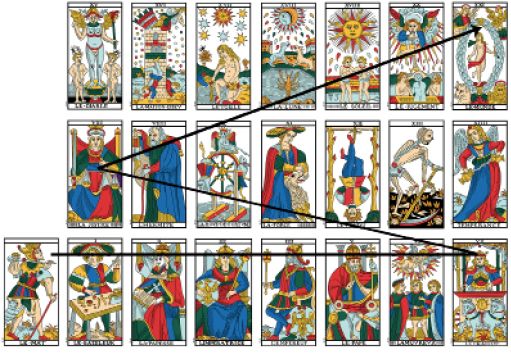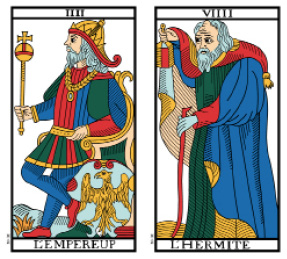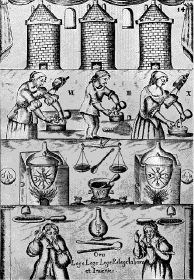3.3 Some meanings of the Tarot
Before venturing into a more detailed study of the Coded Structure , we should perhaps overview some general considerations regarding the meaning of the Tarot. What is commonly believed about it? We may divide the tendencies of opinion into two large groups:
- the diffident
-
the
trusting.
We might imagine that to the first category belong only those who, believing the terrestrial world the only possible reality, laugh at the naivetè or the gullability of those who, on the contrary, believe in a spiritual dimension of existence. This tendency, which already accompanies, as obstacle, many disciplines, from religion itself to the most evolved esoterical practices, with regard to our subject, complicates the scenario even more. With this group, in fact, whom we have called the diffident, are aligned also those who, although confident of a more ample sense of life, still consider the Tarot, at best, a simple instrument of divination, unworthy of a qualification. In this case, the diffident believe that the Arcana are useful for nothing more than fortune-telling. As witnessed by the great blossoming of so many holistic initiatives and roads to knowledge all over the world (also in the West), humanity, tired of a materialism taken to the extreme, seeks its own well-being in a new, more natural and personal dimension. And yet, few are they who have seen in these Icons, a means to reach this condition. Most, also influenced by the lack of knowledge of recent centuries, relegate them to a witchly, and often satanic, sphere.
In the second category, that of the trusting, we find those who admit or are convinced that the Tarot may have a profound content. Not only those, even of great commitment, who have dedicated themselves seriously and passionately to study, but also those who turn to the Tarot with hope of an authentic and fruitful contribution with respect to their own needs and necessities. Nevertheless, in this second case as well, there are diverse barriers to overcome before one is able to comprehend the true significance of these Icons. The first step to take in this direction, is to rid the field of a grave preconception:
the
principal purpose of theTarot is not divination!
If it is true that this exists, it is only one of the multiple forms of expression of this complex Metaphysical Machine and certainly not the most notable In order to avoid misunderstanding, we must clarify the concept.
The art of predicting the future, when practiced with cards, is termed cartomancy, a word etymologically composed of the Greek carta and manteia , which means, in fact, divination. Modern historiography, as we have said, puts the first appearance of the cards in Europe in the XIV century. Fernando della Torre, in a letter of 1450, addressed to the Spanish court, describes the manner in which players, using a variant elaborated by him, “ could interrogate the future in order to know by whom they are more loved and whom they desired more and to know many other things . 50 ”
However, we find more specific testimony only in the 500’s : Pico della Mirandola includes “ figured images in a game of cards 51 ” as one of several forms of witchcraft; and the Mainzer Kartenlosbuch (The Mainz Fortune Telling Book), considered the first book on cartomancy, is printed in Magonza in 1505. All of these cases refer to playing cards, as the use of the Tarot, or Triumphs, 52 is seen only in 1527 with the text The Chaos of the Triperuno of Teofilo Folengo (also known as Merlin Cocai). Other, similar, volumes in the principal European languages are printed only between the late XV and all of the XVI centuries. Therefore, we may say that scholars attribute the practice of the first forms of prediction, first to playing cards and only later, to the Tarot. We would like to clarify that our position is totally divergent. As we have had occasion to repeat, it is not the Tarot that derives from playing cards, but the opposite. With the progressive degeneration of its symbolism, there was a concomitant increase in the divinatory practice as it is known today which is itself, as a matter of fact, a degenerate and secondary form of prediction with respect to prophecy (which is, according to sacred texts, of great value and is practiced through divine inspiration).
However that may be, the greatest number of documents on this theme, are traceable from the XVIII century forward, and the father of cartomancy is universally considered Jean-Baptiste Alliette (1738-1791). From this period on, in fact, there was only a gradual drift towards the divinatory use of the Tarot, which will become ever more popular, vast and in some ways corrupt, and which will reach its height in the 1900’s thanks to the ever more abundante publication of books and manuals. Precisely because this use of the cards and its explosive spread, led to completely deviated forms of expression, we consider it superfluous to remember the total degardation of the current reputation of the Tarot. It is thus quite normal for those who today seek a Path of interior and spiritual development, to harbor diffidence and perplexity towards this means. For this reason we have chosen to bring light to the subject, with the hope of inspiring a radical change of perception that may restore to the Tarot its lost integrity. However, if the practice of cartomancy is not prioritary, what is the purpose of the Arcana? We present several hypotheses which will be the object of later analyses.
It is a Road in stages, 21 to be precise, through which the traveler, the card without number, the Fool, heads towards the World, the last Arcanum, with his gaze turned to the sky, seeking to gain complete realization. The Tarot is a Path upon which the consciousness is encouraged to increase, it is a Way of pregressive evolution.

Fig. 28
The Path of Awareness
Let us observe, as if it were a game, the Roman numerals of certain Arcana: they are not written in a regular manner, according to the correct principles. The 4, in Roman numerals, should be written IV and instead is written IIII; the 9 should be IX and instead is VIIII, etc. Why?

Fig. 29
The two progressive numbers
The reply is simple: in this way, avoiding the subtraction (I from V or I from X), we add... (III+I or VIII+I)! The Tarot is a Way of continuous additon, of expansion of the consciouness. This deals with only a small, very simple Code, indicative however of the fact that, to study the Tarot means to seek contact with the deepest part of oneself, with one’s own Soul.
“ The Tarot is a book written in symbols . 53 ” This book, made up of thousands of pages, contains precise, authentic wisdom regarding man, his essence, and the laws that govern him. If we marvel at the fact that texts such as the Bible or the Veda are revealed books, then we must marvel in equal measure that the Tarot is a depositary of exceptional wisdom.
We should stipulate that this parallelism has nothing of the irreverent because in both cases they are Sacred Works, the sole differnce being that the Tarot communicates this Wisdom through images. There exists an ancient work, the Mutus Liber which, as the name itself, Mute Book, says, is a compendium of 15 tables perfectly representing, according to Alchemy, the process of transmutation and interior transformation.
In one of the illustrations, the penultimate, we find this expression: “ Ora, Lege, Lege, Lege, Rilege, Labora et inveniens . 54 ”
Thus, to those who apply to the Tarot the same principal, to those who knock at its door with Love, Will and Intelligence, will be revealed its deepest mistery.

Fig. 30
Mutus Liber
The Tarot, thanks to the group of symbols of which it is constituted, creates a language. This is not, as we might suppose, an allegory, but a true fact. As we will see, there exist a Grammar and a Lexicon, 55 elements which, combined amomg themselves, allow the learning of a new language. This seems an event so stupefying as to be difficult to believe, at least until we see it in practice. When we ask a question, there exists a level totally unknown beyond other planes of interpretation, such as the well-known archetypical 56 : the Tarot, as a superior Intelligence , through “words” and “rules” composes exact propositions which answer precisely the question asked by the consultant! One who, in this phase, may desire to have an idea of the type of mechanism, might try to imagine the I Ching . 57 The difference is in the type of answer which, with the Tarot, is not formulated in a metaphorical manner but created with sentences which perfectly answer the question. These assertions, apart from their objective clarity, are charaterized by a truely disconcerting rigor and intelligence and become a concrete and precious aid for whomever receives them. We see here, then, one of the principal functions of the Arcana, who place themselves, together with the tarologist (translator of their message), at the Service of mankind.
In conclusion. we would like to share some personal considerations. The significance of the Tarot and its possible applications, go far beyond our current affirmations. However, in order to maintain a scientific attitude, proveable and disciplined, we must first of all verify the hypothses accepted up till now which, after the the indispensable demonstrations, will be recovered and amplified in the last chapters. This choice is tied also to the will to respect the needs of those who access this subject for the first time according to the present system. In fact, we wish to set up our work with the intent of avoiding easy skepticism or incredulity, or on the contrary, an excess of enthuisiasm. Our hope is that the reader, through a fluidity of comprehension, gradual but progressive, may reap the benefits that the first approach to the Coded Structure of the Tarot may offer .